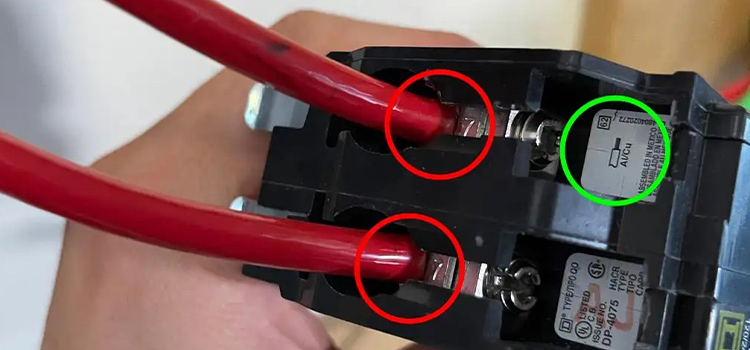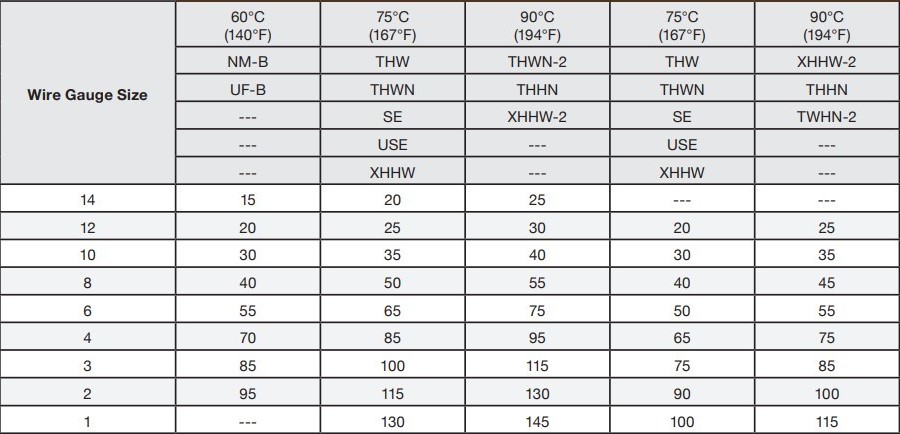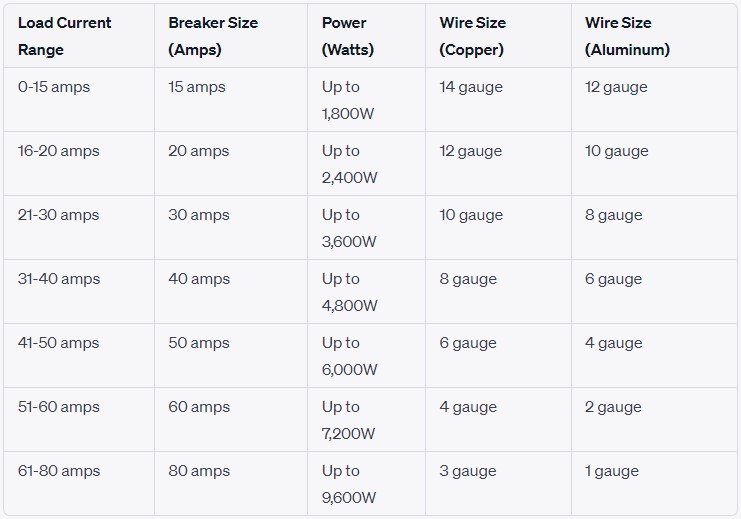What Size Wire for 60 Amp Breaker Is Recommended? | Below or Under 6 AWG?
Electricians and specialists recommend utilizing wire gauges ranging from 6 AWG to 4 AWG for 60-ampere breakers. As all household wires are rated at least 600 volts, the sole factor that determines the wire gauge is amperage. As a result, the wire size for a 60 amp 220v circuit is still 6 to 4 AWG.

What Is Ampacity?
Ampacity can be thought of as the maximum amount of current that can flow through a particular wire size at a given temperature and voltage drop. The length of a wire should not be used to determine its size. The larger the gap between your panel and subpanel, or load location to the subpanel, the greater the conductors required.
To minimize larger voltage dips, you must take ampacity seriously and choose wire size properly. The ampacity tables do not account for every possible wire, temperature, and voltage drop combination. The figures are for dry, clean conditions.
They believe the conductor is suitably supported at intervals of no more than 30 feet (9 m). They also presume that any non-CMP cable’s insulation is undamaged and devoid of faults that would make it prone to failure under ultimate load conditions.

Why Wire Size is Important for Breakers?
The size of the wire is crucial for breakers for several important reasons:
Electrical Safety: Using the correct wire size for a given breaker helps prevent electrical fires and hazards. If the wire is too small for the breaker, it can overheat and potentially cause a fire.
Overcurrent Protection: Breakers are designed to protect the wiring and electrical components in a circuit from excessive current (overcurrent). Properly sized wires ensure that the breaker can trip when there is too much current, preventing damage to the circuit and equipment.
Voltage Drop: Inadequate wire size can lead to voltage drop, especially over longer distances. Voltage drop can affect the performance of electrical devices and appliances, causing them to work less efficiently.
Compliance with Codes and Standards: Electrical codes and standards specify the minimum wire size that should be used with specific breakers to ensure safety and proper circuit operation. Using the correct wire size is essential for compliance with these regulations.
Preventing Tripping and Overloading: If the wire is too small, the breaker may trip frequently, leading to inconvenience and potential wear and tear on the breaker. Conversely, using oversized wire can lead to overloading the circuit, which is also dangerous.
Efficient Energy Transfer: Using the right wire size helps ensure efficient energy transfer from the power source to the connected devices. Undersized wire can result in energy losses as heat, reducing the effectiveness of the electrical system.
What Size of Wire is Needed for 60 Amp Breaker?
For a 60-amp breaker, using a 4 AWG wire is safe. The wire gauge is crucial. If you try to utilize wire that is too little in amperage, resistance will cause the wire to become too hot when the optimal current level for which the breaker is rated passes through it.
If that happens, a fire could ignite, which is something you really don’t want to happen. A heavy-gauge wire, on the other hand, is difficult to work with, difficult to link/connect, and has a high cost. Make sure you don’t use too much of a big wire. Many homeowners make the following common error.
They use 6 AWG wire for a 60 amp breaker since 6 AWG gauge wire has a 65A ampacity. On the surface, that appears to be a logical assumption, and it’s an honest error to make. The issue is that if we utilize the 6 AWG wire, we risk burning our 60 amp breaker. However, for overload protection 6 AWG is preferable.
Determinants of Wire Size
The ampacity of a wire should not be the main consideration when choosing a wire size for a 60 amp breaker. We must also follow the guidelines in ‘Chapter 3: NEC CODE Rules and Design Practice’ (particularly, NEC 220-2 and NEC 310-16), which include an 80% breaker rating rule and account for voltage drop.
80% Breaker Rating Rule
According to the NEC Code, the 80 percent breaker rating rule applies to be the most crucial in wire sizing. This guideline is in place to guarantee electrical safety. Assume we need to figure out the wire gauge for a 60 amp breaker. This might be anything from a 60 amp hot tub wire to a 60 amp wire service.
The wire size required for 60 amps is 80% of the wire size required. That means a wire capable of carrying at least 48 amps is required for a 60-amp breaker. Here’s how to perform this calculation:
60 amps x 0.8 = 48 amps Adequate Wire Size
The 4 AWG gauge wire is the next wire size that can withstand more than 75 amps. Even allowing for the fact that 4 AWG can carry 85 amps, it’s more than enough ampacity to adequately wire a 60 amp breaker.
Account For Voltage Drop
You can overlook the voltage loss if you have a short circuit. If you have a long cable connected to a 60 amp breaker, however, you must account for the voltage loss. You can make the error of utilizing a typical 4 AWG gauge wire when you should be using a larger 3 AWG wire if you ignore the voltage drop.
The voltage lowers by 20% for every 100 feet of wire. The actual percentage loss may vary depending on the wire used such as copper, aluminum, iron, steel, etc., and the amount of wires used, but this is the basic rule.
Wire Size For 60-Amp Subpanel 50, 100, or 150 Feet Away
Let’s consider a subpanel 150 feet away to understand the calculation. According to the voltage loss rule of thumb, we lost 30% of the voltage in 150 feet of wire (100 feet = 20% loss, 150 feet = 30% loss). This means we’ll need to boost the amps by 30%. This is how we arrive at the final amps,
75 amps × 1.3 = 97.5 amps
This indicates that a 150-foot-long wire for a 60-amp sub-panel must be capable of carrying at least 97.5 amps. Wire with a gauge of 6 AWG can withstand 65 amps, while wire with a gauge of 4 AWG can handle 85 amps.
Due to the 150-foot distance, both of these lines have insufficient amperage. The following wire size is required: 3 AWG. This wire size is capable of carrying up to 100 amps. In this situation, it’s ideal.
Breaker Size Chart
The appropriate breaker size depends on the specific application and load requirements. Here’s a simplified breaker size chart for various amperage ranges:

Safety First
When working with electrical systems, safety should always be a top priority. Here are some essential safety considerations to keep in mind:
FAQs About What Size Wire for 60 Amp Breaker Is Recommended?
1. What do I need to know about wire sizes?
Answer: Wire sizes are specified by their gauge (AWG – American Wire Gauge) and are crucial in determining the capacity and safety of an electrical circuit. The lower the gauge number, the thicker the wire. Choosing the correct wire size is essential for safe and efficient electrical installations.
2. Why is the right wire size important?
Answer: Using the right wire size is crucial for safety and proper functionality. If the wire size is too small for the current (amperage) it needs to carry, it can overheat, potentially causing fires or equipment damage. Conversely, if the wire size is too large, it can be inefficient and more expensive than necessary.
3. Can 8, 6, and 10 gauge wire handle 60 amps?
Answer: No, 8, 6, and 10-gauge wires are not suitable for a 60-amp circuit. An electrical circuit that carries 60 amps typically requires a minimum wire size of 6 AWG for copper conductors. Using a smaller gauge wire can pose a fire hazard and is not in compliance with electrical codes.
4. What size copper wire is good for 60 amps?
Answer: For a 60-amp circuit, a copper wire with a minimum size of 6 AWG is recommended. This wire size can safely handle 60 amps of current and is compliant with most electrical codes.
5. What do I need to know about wire sizes?
Answer: As mentioned earlier, understanding wire sizes is crucial for electrical safety. Factors to consider include the current requirements of your circuit, the type of conductor (copper or aluminum), the length of the run, and local electrical codes and regulations.
6. What wire do I need for a 60-amp sub-panel?
Answer: For a 60-amp sub-panel, you should use a minimum of 6 AWG copper wire or 4 AWG aluminum wire for the feeder conductors. Additionally, you need to consider the wire size for grounding and neutral conductors, as well as the distance between the main panel and the sub-panel.
7. What gauge wire for 220v 60 amp?
Answer: For a 220-volt 60-amp circuit, you should use a minimum of 6 AWG copper wire or 4 AWG aluminum wire for the hot conductors. The neutral and ground conductors should also match this size. Always consult local electrical codes and regulations for specific requirements in your area.
Final Thoughts
For homeowners who have no experience with electrical repair, determining what size wire to use for a 60 amp breaker can be a total hassle. Hopefully, the details in this article will assist you in choosing the right size wiring for breaker sub-panel maintenance or any other work.
- What Is Ampacity?
- Why Wire Size is Important for Breakers?
- What Size of Wire is Needed for 60 Amp Breaker?
- Determinants of Wire Size
- Account For Voltage Drop
- Wire Size For 60-Amp Subpanel 50, 100, or 150 Feet Away
- Breaker Size Chart
- Safety First
- FAQs About What Size Wire for 60 Amp Breaker Is Recommended?
- Final Thoughts
Subscribe to our newsletter
& plug into
the world of circuits